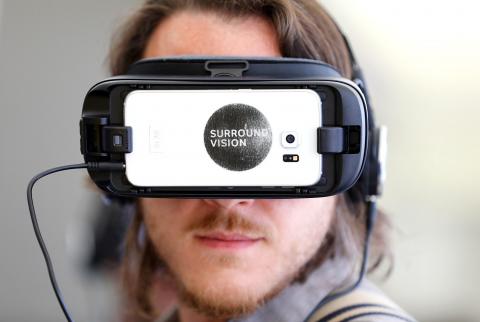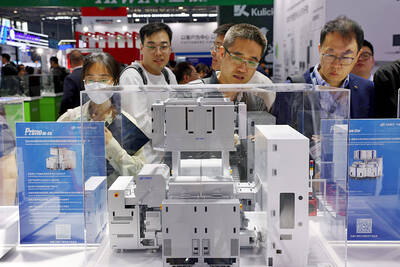Twelve months ago the Virtual Reality (VR) World Congress in Bristol, England, was a sell-out show, with more than 750 attendees gawping over the latest VR hardware and production techniques.
This year’s event, which took place last week, attracted even more participants — more than 1,200 over three days — but the mood felt decidedly less upbeat. Virtual reality, it seems, has been mugged by reality.
Sales of VR hardware have fallen 40 percent behind forecasts, CCS Insight, a technology research group, said in a February report.

Photo: Bloomberg
The VR hardware that is selling has mostly been relatively inexpensive goggles that allow people to experience VR through their smartphones, such as Samsung Electronics Co’s Gear VR and Google’s Daydream, not higher-end, dedicated headsets such as those made by Sony Corp, Facebook Inc’s Oculus and HTC Corp (宏達電).
“Some people have said that 2016 was not a very good year for VR, that perhaps virtual reality is not where we would have hoped,” Roy Taylor, vice president for alliances at semiconductor manufacturer Advanced Micro Devices Inc, said in his keynote address at the conference, before going on to dispute the conclusion.
He listed a series of virtual-reality achievements last year, including the first uses of the technology for surgery and in a courtroom, as well as several significant VR games and films, and yet, talking to exhibitors at the conference, there was a distinct sense that virtual reality has entered the dreaded “trough of disillusionment.”
That is the bust part of the boom-and-bust in public expectations that precedes mass adoption of a new technology in research firm Gartner’s famous “hype cycle.”
“I think the problem was about hype and expectation versus reality,” said Stuart Gallop, chief executive officer of ARiVR, a UK company working on product placement for brand marketing within virtual reality environments such as games and movies.
Many working in VR have run up against the hard economic reality of trying to produce content for a technology that remains, at least for the moment, fairly niche.
Daniel Kihlgren Kallander, a developer and programmer for the Swedish virtual reality start-up Svrvive ABAB, said that his company lost money on its first VR game, also called Svrvive, which it released for HTC’s Vive platform last year.
“This is a very small market right now,” he said. “We need a bigger market to sustain ourselves. This is doubly true for those working on virtual-reality films, as opposed to computer games.”
Edward Saatchi, chief executive officer and cofounder of Oculus Story Studio, a VR movie studio owned by Facebook’s Oculus, compared early experiments in VR films with the transition from silent movies to talkies in the late 1920s, except, he said of those pioneers in sound: “At least they had a business model.”
As disappointment is setting in for virtual reality, expectations are building around its less glamorous cousin, augmented reality (AR), which is also sometimes called mixed reality, because it places digitally-rendered elements in the real observed environment.
Last year, Pokemon Go, which is an augmented-reality game played on smartphones, became a worldwide phenomenon.
Microsoft Corp launched its high-end AR headset, HoloLens, which has found customers mostly among industrial and business users — such as aeronautical engineers and architects.
Snap Inc’s AR photograph filters are one of the most popular features of its messaging service and Facebook has announced a big push into the field with its own AR camera filters.
Many now expect Apple Inc to introduce an augmented-reality product in the next year, which might help AR to leapfrog VR to achieve mass adoption.
“Apple has not made a play yet in this space and I think they will, and that it will be huge,” Gallop said.
Technology company ABI Research said that virtual reality generates about 50 percent more revenue than augmented reality, but that it relies heavily on hardware sales.
Augmented reality, by contrast, relies more on software and in many cases can be experienced by users with their smartphones.
ABI forecasts that AR revenues will surpass VR sales by 2019.
Virtual-reality true believers, like Taylor, are dismissive of the idea that AR might outrun VR as a blockbuster consumer technology.
Augmented reality requires too much training for the average consumer to learn how to integrate the digital images into the real world, Taylor said.
“Mixing the virtual world and the real world is less natural,” he said.
VR enthusiasts think the current “trough of disillusionment” is — as the Gartner model would predict — merely a temporary setback on the road to virtual reality becoming a mainstream technology — and a cash cow.
The question though, is how long the field will have to wallow in the trough.

With this year’s Semicon Taiwan trade show set to kick off on Wednesday, market attention has turned to the mass production of advanced packaging technologies and capacity expansion in Taiwan and the US. With traditional scaling reaching physical limits, heterogeneous integration and packaging technologies have emerged as key solutions. Surging demand for artificial intelligence (AI), high-performance computing (HPC) and high-bandwidth memory (HBM) chips has put technologies such as chip-on-wafer-on-substrate (CoWoS), integrated fan-out (InFO), system on integrated chips (SoIC), 3D IC and fan-out panel-level packaging (FOPLP) at the center of semiconductor innovation, making them a major focus at this year’s trade show, according

DEBUT: The trade show is to feature 17 national pavilions, a new high for the event, including from Canada, Costa Rica, Lithuania, Sweden and Vietnam for the first time The Semicon Taiwan trade show, which opens on Wednesday, is expected to see a new high in the number of exhibitors and visitors from around the world, said its organizer, SEMI, which has described the annual event as the “Olympics of the semiconductor industry.” SEMI, which represents companies in the electronics manufacturing and design supply chain, and touts the annual exhibition as the most influential semiconductor trade show in the world, said more than 1,200 enterprises from 56 countries are to showcase their innovations across more than 4,100 booths, and that the event could attract 100,000 visitors. This year’s event features 17

Germany is to establish its first-ever national pavilion at Semicon Taiwan, which starts tomorrow in Taipei, as the country looks to raise its profile and deepen semiconductor ties with Taiwan as global chip demand accelerates. Martin Mayer, a semiconductor investment expert at Germany Trade & Invest (GTAI), Germany’s international economic promotion agency, said before leaving for Taiwan that the nation is a crucial partner in developing Germany’s semiconductor ecosystem. Germany’s debut at the international semiconductor exhibition in Taipei aims to “show presence” and signal its commitment to semiconductors, while building trust with Taiwanese companies, government and industry associations, he said. “The best outcome

Semiconductor equipment billings in Taiwan are expected to double this year, as manufacturers in the industry are keen to expand production to meet strong global demand for artificial intelligence applications, according to SEMI, which represents companies in the electronics manufacturing and design supply chain. Speaking at a news conference before the opening of Semicon Taiwan trade show tomorrow, SEMI director of industry research and statistics Clark Tseng (曾瑞榆) said semiconductor equipment billings in Taiwan are expected to grow by an annual 100 percent this year, beating an earlier estimate of 70 percent growth. He said that Taiwan received a boost from a